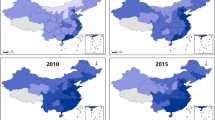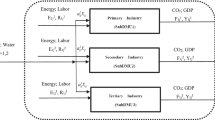Abstract
Industry is the largest sector for energy consumption and pollution emissions in China. Thus, improving industrial eco-efficiency is necessary for China to achieve sustainable development. Based on panel data from 31 industrial sectors from 2001 to 2015, a three-stage data envelopment analysis model was used to empirically explore industrial eco-efficiency and its influencing factors from the perspective of industrial heterogeneity. The results show that the overall level of industrial eco-efficiency in China is not high, first declining and then rising during the study period. Low eco-efficiency was mainly due to low scale efficiency. After removing the influences of external environmental factors and noise, industry profit rates, ownership structures, and foreign direct investments were all significantly and positively correlated with eco-efficiency. Environmental regulations were significantly and negatively correlated, while the intensity of research and development exhibited no linear relationship. Industrial heterogeneity significantly affects eco-efficiency. Capital-intensive industries had the highest eco-efficiencies, followed by resource-intensive industries and labor-intensive industries, respectively.
Graphic abstract
Comparison of technical efficiency (TE) before and after adjustment on a panel of 31 industries in China from 2001 to 2015.






Similar content being viewed by others

Availability of data and material
The data used in this paper are from China’s statistical yearbook (2002–2016) and China’s environmental statistical yearbook (2002–2016).
Code availability
DEAP v. 2.1; Frontier4.1 software.
References
Banker RD, Charnes A, Cooper WW (1984) Some models for estimating technical and scale inefficiencies in data envelopment analysis. Manag Sci 30:1078–1092
Charmondusit K, Phatarachaisakul S, Prasertpong P (2013) The quantitative eco-efficiency measurement for small and medium enterprise: a case study of wooden toy industry. Clean Technol Environ Policy 16:935–945
Chen F, Zhao T, Wang J (2019) The evaluation of energy-environmental efficiency of China’s industrial sector: based on Super-SBM model. Clean Technol Environ Policy 21:1397–1414
Chowdhury JI, Yk H, Haltas I et al (2018) Reducing industrial energy demand in the UK: a review of energy efficiency technologies and energy saving potential in selected sectors. Renew Sustain Energy Rev 94:1153–1178
Coelli TJ (1996a) A guide to DEAP Version 2.1: a data envelopment analysis (computer) program. CEPA working paper. Centre for Efficiency and Productivity Analysis, University of New England, Armidale
Coelli TJ (1996b) A guide to FRONTIER version 4.1: a computer program for stochastic frontier production and cost function estimation, vol 7. CEPA working papers
Crijns GW, Yue H, Zhang SH et al (2020) Energy efficiency improvement opportunities in the global industrial sector. Encycl NA Sustain Mater 5:377–388
Ezici B, Egilmez G, Gedik R (2020) Assessing the eco-efficiency of U.S. manufacturing industries with a focus on renewable vs. non-renewable energy use: An integrated time series MRIO and DEA approach. J Clean Prod 253:119630. https://doi.org/10.1016/j.jclepro.2019.119630
Gray WB (1987) The cost of regulation: OSHA, EPA and the productivity slowdown. Am Econ Rev 77:998–1006
Guo SD, Tong M, Guo J et al (2018) Measurement and influencing factors of inter-provincial real environmental efficiency based on three-stage DEA model. China Popul Resour Environ 28:106–116
Haider S, Danish MS, Sharma R (2019) Assessing energy efficiency of Indian paper industry and influencing factors: a slack-based firm-level analysis. Energy Econ 81:454–464
Hashimoto SJ, Moriguchi YC (2004) Proposal of six indicators of material cycles for describing society’s metabolism: from the viewpoint of material flow analysis. Resour Conserv Recycl 40:185–200
Iftikhar Y, Wang ZH, Zhang B et al (2018) Energy and CO2 emissions efficiency of major economies: a network DEA approach. Energy 147:197–207
IPCC (2019) 2019 Refinement to the 2006 IPCC guidelines for national greenhouse gas inventories. https://www.ipcc-nggip.iges.or.jp/public/2019rf/index.html. Accessed 12 May 2019
Kumbhakar SC (2000) Stochastic frontier analysis. Cambridge University Press, Cambridge
Letchumanan R, Kodama F (2000) Reconciling the conflict between the “pollution-haven” hypothesis and an emerging trajectory of international technology transfer. Res Policy 29:59–79
Li XP, Li XK (2017) Study on the differences and convergence of industry environment regulation intensity in China. China Popul Resour Environ 27:1–9
Li K, Lin B (2016) Impact of energy conservation policies on the green productivity in China’s manufacturing sector: evidence from a three-stage DEA model. Appl Energy 168:351–363
Li BQ, Wang ZQ, Chai J et al (2019a) Index system to assess implementation of strategic land use plans in China. Land Use Policy 88:104148
Li HK, He HY, Shan JF et al (2019b) Innovation efficiency of semiconductor industry in China: a new framework based on generalized three-stage DEA analysis. Soc Econ Plan Sci 66:136–148
Lim S, Zhu J (2016) A note on two-stage network DEA model: frontier projection and duality. Eur J Oper Res 248:342–346
Liu BL, Bian Y, Zhou M et al (2019) 70 years review of China’s regional economic development and its prospect. Ind Econ 9:24–41
Liu Z, Zhang H, Zhang YJ et al (2020) How does industrial policy affect the eco-efficiency of industrial sector? Evidence from China. Appl Energy 272:115206
Lu X, Xu CX (2019) The difference and convergence of total factor productivity of inter-provincial water resources in China based on three-stage DEA-Malmquist index model. Sustain Comput Inform Syst 22:75–83
Mansour A, Kanso L (2018) Science park implementation-a proposal for merging research and industry in developing Arab countries. HBRC J 14:3
Marques AC, Fuinhas JA, Tomás C (2019) Energy efficiency and sustainable growth in industrial sectors in European Union countries: a nonlinear ARDL approach. J Clean Prod 239:118045
OECD (1998) Organization for economic co-operation and development. Eco-efficiency. OECD, Paris
Park JY, Park JM, Park HS (2018) Scaling-up of industrial symbiosis in the Korean national eco-industrial park program: examining its evolution over the 10 years between 2005–2014. J Ind Ecol 23:197–207
Porter ME, Van DLC (1995) Toward a new conception of the environment-competitiveness relationship. J Econ Perspect 9:97–118
Quarriguasi FNJ, Walther G, Bloemhof J et al (2009) A methodology for assessing eco-efficiency in logistics network. Eur J Oper Res 193(3):670–682
Ren XY, Yang SL (2013) An empirical research on the relationship between foreign direct investment and carbon dioxide emission intensity of China. Adv Mater Res 807–809:951–957
Schaltegger S, Sturm A (1990) Ecological rationality: approaches to design of ecology-oriented management instruments. Die Unternehm 44:273–290 (in German)
Shah AA, Wu DD, Korotkov V et al (2019) Do commercial banks benefited from the belt and road initiative? A three-stage DEA-tobit-NN analysis. IEEE Access 7:37936–37949
Shao LG, Yu X, Feng C (2019) Evaluating the eco-efficiency of China’s industrial sectors: a two-stage network data envelopment analysis. J Environ Manag 247:551–560
Tenente M, Henriques C, Silva PP (2020) Eco-efficiency assessment of the electricity sector: evidence from 28 European Union countries. Econ Anal Policy 66:293–314
Verfaillie HA, Bidwell R (2000) Measuring eco-efficiency: a guide to reporting company performance. WBCSD, Geneva
Walheer B, He M (2020) Technical efficiency and technology gap of the manufacturing industry in China: does firm ownership matter? World Dev 127:104769
Yang QY, Song DY (2019) How does environmental regulation break the resource curse: theoretical and empirical study on China. Resour Policy 64:101480
Zhao S, Liu H (2016) Evaluation of industrial enterprise’s eco-efficiency based on three-stage DEA model in China. Ecol Econ 11:88–91
Zhao CH, Zhang HN, Zeng YR et al (2018) Total-factor energy efficiency in BRI countries: an estimation based on three-stage DEA model. Sustainability 10(2):278
Zhao H, Guo S, Zhao H (2019) Provincial energy efficiency of China quantified by three-stage data envelopment analysis. Energy 166:96–107
Zhou SJ, Liao FF, Li DY (2017) Research on energy efficiency of Chinese industry consider industrial heterogeneity. Ind Econ Rev 8(1):31–44
Acknowledgements
The research is supported by the major program of philosophy and social science in Anhui Province (No. AHSKZD2018D04). We appreciate the anonymous reviewers for their valuable comments on our study.
Funding
The research is supported by the major program of philosophy and social science in Anhui Province (No. AHSKZD2018D04).
Author information
Authors and Affiliations
Contributions
YZ contributed to methodology and writing—original draft preparation. ZL supervised and conceptualized the study. SL contributed to data curation and software. MC contributed to visualization. XZ contributed to investigation and validation. YW reviewed and edited the manuscript.
Corresponding author
Ethics declarations
Conflict of interest
The author(s) declare that they have no competing interests.
Additional information
Publisher's Note
Springer Nature remains neutral with regard to jurisdictional claims in published maps and institutional affiliations.
Electronic supplementary material
Below is the link to the electronic supplementary material.
Rights and permissions
About this article
Cite this article
Zhou, Y., Liu, Z., Liu, S. et al. Analysis of industrial eco-efficiency and its influencing factors in China. Clean Techn Environ Policy 22, 2023–2038 (2020). https://doi.org/10.1007/s10098-020-01943-7
Received:
Accepted:
Published:
Issue Date:
DOI: https://doi.org/10.1007/s10098-020-01943-7



